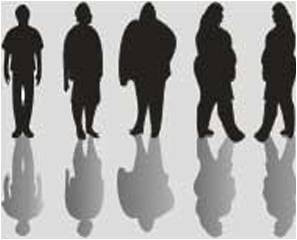The U.S. obesity prevalence increased from 13 percent to 32 percent between the 1960s and 2004.
The U.S. obesity prevalence increased from 13 percent to 32 percent between the 1960s and 2004, according to researchers at the Johns Hopkins Bloomberg School of Public Health Center for Human Nutrition. The prevalence of obesity and overweight has increased at an average rate of 0.3–0.8 percentage points across different sociodemographic groups over the past three decades.
Some minority and low socioeconomic status groups—such as non-Hispanic black women and children, Mexican-American women and children, low socioeconomic status black men and white women and children, Native Americans and Pacific Islanders—are disproportionately affected.“The obesity rate in the United States has increased at an alarming rate over the past three decades. We set out to estimate the average annual increase in prevalence as well as the variation between population groups to predict the future situation regarding obesity and overweight among U.S. adults and children,” said Youfa Wang, MD, PhD, lead author of the study and an assistant professor in the Bloomberg School of Public Health’s Department of International Health. “Obesity is a public health crisis.
If the rate of obesity and overweight continues at this pace, by 2015, 75 percent of adults and nearly 24 percent of U.S. children and adolescents will be overweight or obese.”
The study authors included 20 journal papers, reports and online data sets in their meta-analysis. In addition, data from four national surveys—NHANES, BRFSS, Youth Risk Behavior Surveillance System and National Longitudinal Survey of Adolescent Health—were included in order to examine the disparities in obesity.
They defined adult overweight and obesity using body mass index cutoffs of 25 and 30, respectively. Children at risk for overweight and overweight were classified as being in the 85th and 95th percentiles of body mass index, respectively. The key findings include:
· 66% of U.S. adults were overweight or obese in 2003-2004.
· Women 20–34 years old had the fastest increase rate of obesity and overweight.
· 80% of black women aged 40 years or over are overweight; 50% are obese.
· Asians have a lower obesity prevalence when compared to other ethnic groups. However, Asians born in the United States are four times more likely to be obese than their foreign-born counterparts.
· Less educated people have a higher prevalence of obesity than their counterparts, with the exception of black women.
· States in the southeast have higher prevalence than states on the West Coast, the Midwest and the Northeast.
· 16% of children and adolescents are overweight and 34% are at risk of becoming overweight in 2003-2004.
· White children and adolescents had the lowest prevalence of overweight and being at risk of overweight compared with their black and Mexican counterparts.
“Our analysis showed patterns of obesity or overweight for various groups of Americans. All groups consistently increased in obesity or overweight prevalence, but the increase varied by group, making this public health issue complex.
Advertisement
“Obesity is likely to continue to increase, and if nothing is done, it will soon become the leading preventable cause of death in the United States.”
Advertisement
Source-Eurekalert
JAY/M











